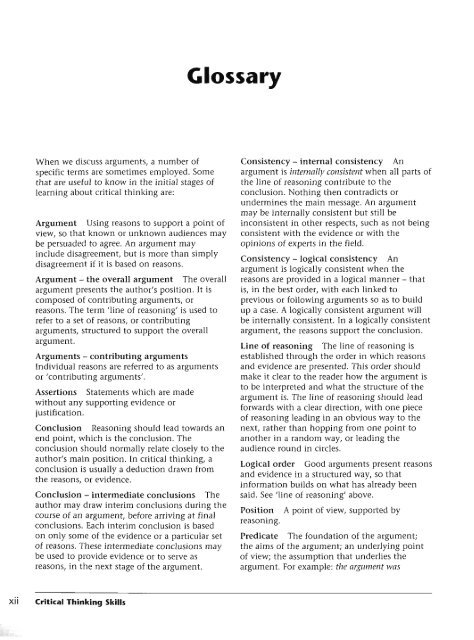Critical Thinking Skills - Developing Effective Analysis and Argument(2)
Critical Thinking Skills - Developing Effective Analysis and Argument(2)
Critical Thinking Skills - Developing Effective Analysis and Argument(2)
You also want an ePaper? Increase the reach of your titles
YUMPU automatically turns print PDFs into web optimized ePapers that Google loves.
Glossary<br />
When we discuss arguments, a number of<br />
specific terms are sometimes employed. Some<br />
that are useful to know in the initial stages of<br />
learning about critical thinking are:<br />
<strong>Argument</strong> Using reasons to support a point of<br />
view, so that known or unknown audiences may<br />
be persuaded to agree. An argument may<br />
include disagreement, but is more than simply<br />
disagreement if it is based on reasons.<br />
<strong>Argument</strong> - the overall argument The overall<br />
argument presents the author's position. It is<br />
composed of contributing arguments, or<br />
reasons. The term 'line of reasoning' is used to<br />
refer to a set of reasons, or contributing<br />
arguments, structured to support the overall<br />
argument.<br />
<strong>Argument</strong>s - contributing arguments<br />
Individual reasons are referred to as arguments<br />
or 'contributing arguments'.<br />
Assertions Statements which are made<br />
without any supporting evidence or<br />
justification.<br />
Conclusion Reasoning should lead towards an<br />
end point, which is the conclusion. The<br />
conclusion should normally relate closely to the<br />
author's main position. In critical thinking, a<br />
conclusion is usually a deduction drawn from<br />
the reasons, or evidence.<br />
Conclusion - intermediate conclusions The<br />
author may draw interim conclusions during the<br />
course of an argument, before arriving at final<br />
conclusions. Each interim conclusion is based<br />
on only some of the evidence or a particular set<br />
of reasons. These intermediate conclusions may<br />
be used to provide evidence or to serve as<br />
reasons, in the next stage of the argument.<br />
Consistency - internal consistency An<br />
argument is inte7nally consistent when all parts of<br />
the line of reasoning contribute to the<br />
conclusion. Nothing then contradicts or<br />
undermines the main message. An argument<br />
may be internally consistent but still be<br />
inconsistent in other respects, such as not being<br />
consistent with the evidence or with the<br />
opinions of experts in the field.<br />
Consistency - logical consistency An<br />
argument is logically consistent when the<br />
reasons are provided in a logical manner - that<br />
is, in the best order, with each linked to<br />
previous or following arguments so as to build<br />
up a case. A logically consistent argument will<br />
be internally consistent. In a logically consistent<br />
argument, the reasons support the conclusion.<br />
Line of reasoning The line of reasoning is<br />
established through the order in which reasons<br />
<strong>and</strong> evidence are presented. This order should<br />
make it clear to the reader how the argument is<br />
to be interpreted <strong>and</strong> what the structure of the<br />
argument is. The line of reasoning should lead<br />
forwards with a clear direction, with one piece<br />
of reasoning leading in an obvious way to the<br />
next, rather than hopping from one point to<br />
another in a r<strong>and</strong>om way, or leading the<br />
audience round in circles.<br />
Logical order Good arguments present reasons<br />
<strong>and</strong> evidence in a structured way, so that<br />
information builds on what has already been<br />
said. See 'line of reasoning' above.<br />
Position A point of view, supported by<br />
reasoning.<br />
Predicate The foundation of the argument;<br />
the aims of the argument; an underlying point<br />
of view; the assumption that underlies the<br />
argument. For example: the argument was<br />
~ii <strong>Critical</strong> <strong>Thinking</strong> <strong>Skills</strong>



